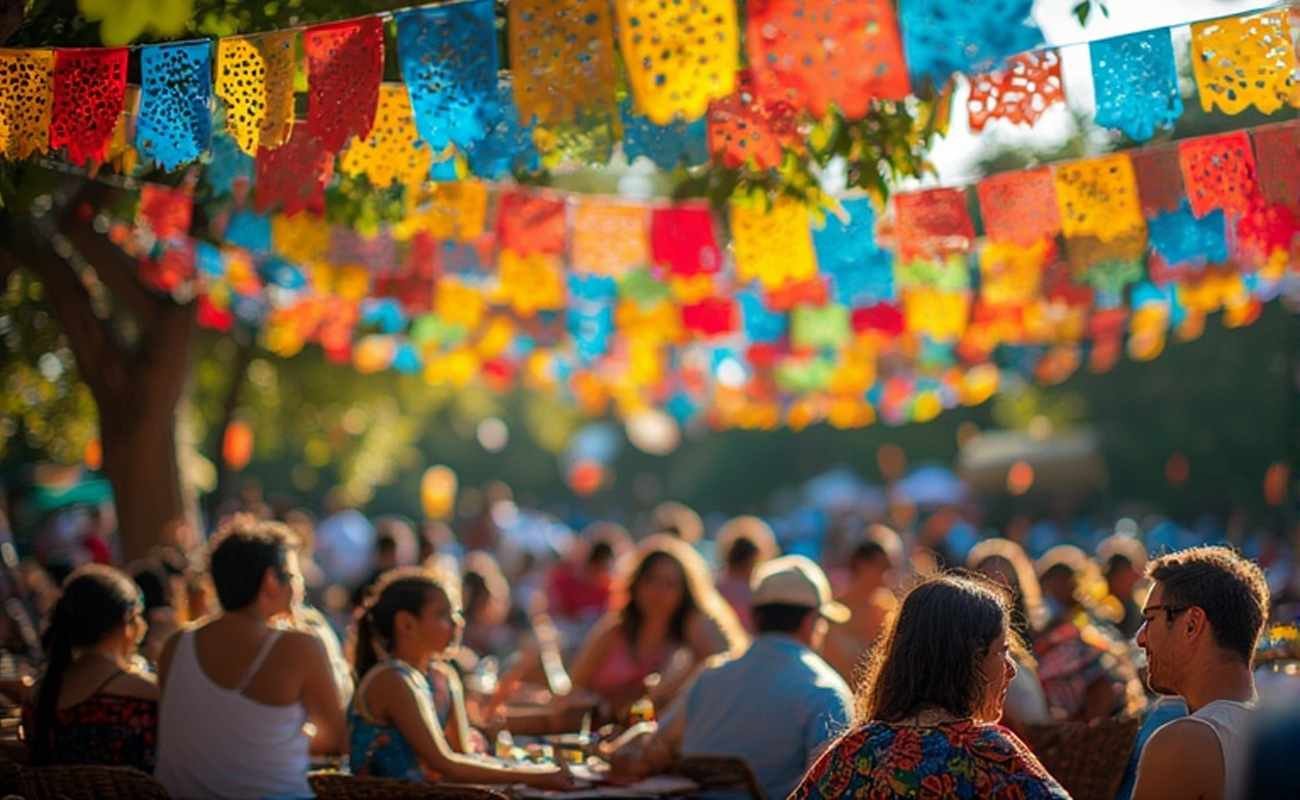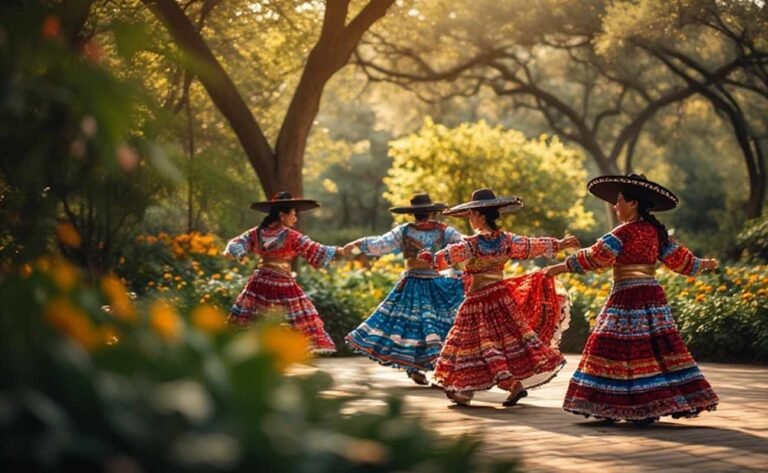Why Dallas Arboretum’s Hispanic Heritage Fest Feels Like a Living Canvas
The Dallas Arboretum’s Hispanic Heritage Celebration transforms the botanical gardens into a vibrant, interactive masterpiece every September, blending Latin American culture with stunning natural landscapes. This annual event, now in its eighth year for 2025, runs on September 13-14 and features live music, authentic food, local vendors, cooking demonstrations, children’s activities, and a popular Quinceañera fashion show. What makes it feel like a living canvas is the seamless fusion of colorful art installations, dynamic performances, and the garden’s blooming flora, creating an immersive experience that evolves with each visitor’s step. Admission is free with a general garden ticket, making it accessible for families and culture enthusiasts alike.
Visitors often describe the fest as a breathing artwork because the event highlights Hispanic traditions through visual and sensory elements that mirror a painter’s palette. From mariachi bands echoing through flower-lined paths to intricate cultural displays set against autumn blooms, the celebration brings history and heritage to life in real time. Moreover, partnerships with local organizations ensure authenticity, while the garden’s 66 acres provide a natural backdrop that enhances every cultural expression. If you’re in Dallas during Hispanic Heritage Month, this fest offers a unique way to engage with diverse traditions in a setting that feels alive and ever-changing.
Key Elements That Make the Event a Dynamic Cultural Masterpiece
Transitioning from the basics, let’s dive into what truly sets this celebration apart. The Dallas Arboretum turns its grounds into something special during this time, where culture and nature collide in unexpected ways. I’ve attended events like this before, and it’s always surprising how the gardens seem to respond to the energy of the crowd – flowers popping against colorful dresses, music blending with bird calls. But enough about that; here’s a breakdown of the core components that contribute to that living canvas vibe.
Visual Fusion of Nature and Hispanic Art Traditions
One major reason the fest evokes a living artwork is the intentional blend of botanical beauty with Hispanic artistic elements. Organizers curate displays that incorporate traditional motifs into the garden layout, making every corner feel like a brushstroke on a giant canvas.
- Colorful Floral Installations Inspired by Latin Motifs: The gardens feature arrangements mimicking Aztec patterns or Mexican folk art, using vibrant blooms like marigolds and dahlias to create living murals. These setups change with the light throughout the day, adding depth just like layers in a painting.
- Interactive Art Stations: Guests can participate in creating papel picado or painting alebrijes, turning passive viewing into active involvement. This hands-on approach makes the event feel alive, as creations accumulate and evolve.
- Sculptural Elements from Local Artists: Hispanic sculptors contribute pieces that integrate with the landscape, such as metalwork figures among the trees, symbolizing cultural roots growing in Texas soil.
- Lighting and Shadow Play: As evening approaches, subtle lights highlight cultural symbols, casting shadows that dance like animated sketches.
- Photographic Backdrops: Designated spots with themed decorations encourage selfies, essentially letting visitors “enter” the canvas and become part of the art.
To illustrate how these elements stack up, check this table comparing visual highlights from past years:
| Year | Key Visual Theme | Notable Installation | Visitor Impact |
|---|---|---|---|
| 2023 | Folk Art Revival | Giant papel picado arches over pathways | Increased photo shares by 40% on social media |
| 2024 | Indigenous Patterns | Blooming mandalas with native plants | Drew 15,000 attendees for interactive sessions |
| 2025 | Modern Fusion | LED-lit alebrijes among autumn pumpkins | Expected to boost engagement with tech integrations |
These visuals don’t just decorate; they tell stories, much like a canvas narrates through colors and forms.
Performance Lineup: Bringing Movement to the Botanical Scene
Moving on, performances inject motion into the static beauty of the gardens, making the whole place pulse with energy. It’s like watching a painting come alive – static elements suddenly dance. The schedule packs in diverse acts that reflect Hispanic diversity, from Mexico to the Caribbean.
Here’s a detailed list of typical performances, based on recent lineups:
- Mariachi Bands: Groups like Mariachi Rosas Divinas perform classics in the entry plaza, their trumpets and violins harmonizing with rustling leaves for an acoustic layer that’s uniquely outdoor.
- Folk Dance Troupes: Ballet Folklórico dancers in swirling skirts perform regional styles, their footwork creating rhythms that echo across lawns.
- Live Music Sets: Bands covering salsa, cumbia, and reggaeton keep crowds moving, with stages set amid flower beds for a surrounded-by-nature feel.
- Quinceañera Fashion Show: A highlight where young women model elaborate gowns, parading through garden paths like living portraits of tradition.
- Storytelling Sessions: Elders share oral histories under shaded arbors, adding narrative depth to the visual spectacle.
- Drumming Circles: Interactive percussion from Puerto Rican and Cuban influences invites participation, turning spectators into performers.
For a clearer view, this table outlines the 2025 tentative schedule (subject to changes; check official sources for updates):
| Day | Time | Performance | Location | Description |
|---|---|---|---|---|
| Saturday, Sept 13 | 10-11 AM | Quinceañera Fashion Show | Rosine Hall | Models showcase traditional and modern dresses with cultural commentary |
| Saturday, Sept 13 | 11-11:30 AM | Mariachi Band | Entry Plaza | Energetic set of traditional Mexican tunes |
| Saturday, Sept 13 | 12-2 PM | Folk Dance Troupe | Main Lawn | Performances from various Latin regions |
| Sunday, Sept 14 | 1-3 PM | Salsa Band | Pavilion | Dance lessons included for audience participation |
| Both Days | Ongoing | Storytelling | Shaded Arbors | Rotating sessions on Hispanic folklore |
These acts ensure the event never feels static – it’s always shifting, much like a canvas under an artist’s evolving hand.
Culinary Experiences: Tasting the Palette of Hispanic Flavors
Now, let’s talk food, because no cultural fest is complete without it, and here it adds a sensory layer that enhances the artistic feel. The aromas and tastes blend with the garden’s scents, creating a full-spectrum experience. Vendors offer bites that represent different countries, making the grounds a flavorful mosaic.
- Authentic Street Foods: Tacos al pastor, empanadas, and arepas from vendors like local Hispanic-owned trucks, served fresh amid blooming settings.
- Cooking Demonstrations: Chefs show how to make tamales or mole, with samples that tie into cultural education.
- Sweet Treats: Churros, flan, and paletas infused with tropical fruits, often using garden-fresh ingredients for a unique twist.
- Beverage Stations: Horchata, aguas frescas, and even craft tequilas for adults, paired with scenic views.
- Vegetarian and Fusion Options: Modern takes like plant-based ceviche, appealing to diverse diets while honoring traditions.
- Family-Friendly Snacks: Kid-approved items like fruit cups with chamoy, encouraging young ones to explore flavors.
To organize the variety, here’s a table of popular food vendors and their specialties from recent events:
| Vendor | Country Influence | Signature Dish | Why It Fits the Canvas Theme |
|---|---|---|---|
| Taqueria El Si Hay | Mexico | Al Pastor Tacos | Bold spices mirror vibrant garden colors |
| Empanada Express | Argentina/Colombia | Beef Empanadas | Flaky textures add tactile element to the experience |
| Paleta Paradise | Various Latin | Fruit Paletas | Refreshing pops of color and flavor amid heat |
| Mole Masters | Mexico | Chicken Mole | Rich sauces like deep paint hues |
| Fusion Flavors | Pan-Latin | Vegan Arepas | Innovative blends reflect evolving art forms |
Eating here isn’t just refueling; it’s part of the immersion, with flavors painting your palate in harmony with the surroundings.
Vendor Marketplace: Shopping the Cultural Mosaic
Shifting gears, the vendor area turns the gardens into a bustling bazaar, where handmade goods add tangible pieces to the living artwork. It’s like collecting souvenirs from a gallery that moves and interacts. Over two dozen Hispanic-owned booths participate, offering items that extend the fest’s theme beyond the weekend.
- Artisan Crafts: Hand-painted pottery, woven textiles, and jewelry inspired by pre-Columbian designs.
- Clothing and Accessories: Embroidered blouses, sombreros, and scarves that visitors wear on-site, becoming part of the visual tapestry.
- Books and Educational Materials: Literature on Hispanic history, perfect for deepening understanding post-event.
- Home Decor: Candles, wall art, and plants with cultural significance, like succulents in decorated pots.
- Beauty Products: Natural soaps and lotions using Latin botanicals, tying back to the garden setting.
- Toys and Games: Traditional items like lotería sets for family fun.
For a snapshot, this table lists vendor categories and examples:
| Category | Examples | Cultural Tie-In | Average Price Range |
|---|---|---|---|
| Crafts | Pottery, Weavings | Aztec/Maya influences | $20-50 |
| Apparel | Blouses, Jewelry | Folk patterns | $15-40 |
| Literature | Books on Heritage | Storytelling traditions | $10-30 |
| Decor | Candles, Art | Home altars inspiration | $25-60 |
| Beauty | Soaps, Lotions | Herbal remedies | $5-20 |
Shopping here supports local creators and lets you take a piece of the canvas home.
Children’s Activities: Engaging Young Minds in the Artwork
Furthermore, the fest includes kid-focused fun that plants seeds of cultural appreciation early. These activities make the gardens a playground of learning, where children contribute to the living canvas through play.
- Craft Workshops: Making piñatas or coloring mandalas with Hispanic themes.
- Storytime Circles: Bilingual readings of folktales under trees.
- Dance Lessons: Simple steps from salsa or folklórico, adapted for little feet.
- Scavenger Hunts: Finding cultural symbols hidden in the gardens.
- Face Painting: Designs like sugar skulls or animal motifs from alebrijes.
- Puppet Shows: Performances retelling legends with handmade puppets.
A quick table of activities by age group:
| Age Group | Activity | Location | Educational Value |
|---|---|---|---|
| 3-6 Years | Face Painting & Crafts | Kids Zone | Introduces colors and shapes culturally |
| 7-10 Years | Scavenger Hunts & Stories | Garden Paths | Builds knowledge of traditions |
| 11+ Years | Dance Lessons & Workshops | Pavilion | Encourages participation in heritage |
These keep families engaged, ensuring the event appeals across generations.
Community Partnerships: The Backbone of Authenticity
Additionally, collaborations with local groups add layers of realness, making the celebration feel like a community-driven artwork. Partners like the Greater Dallas Hispanic Chamber of Commerce bring expertise that enriches every aspect.
- Local Organizations Involved: Groups providing volunteers and content, ensuring diverse representation.
- Sponsorship Highlights: Bank of America as presenter, funding expansions like more stages.
- Educational Tie-Ins: Workshops on Hispanic contributions to Texas history.
- Charity Elements: Portions of proceeds supporting cultural preservation.
- Volunteer Opportunities: Ways for locals to join in, fostering ownership.
This list shows key partners and roles:
- Bank of America: Main sponsor, enables free access features.
- Dallas Hispanic Chamber: Vendor coordination and business spotlights.
- Local Schools: Student performances adding youth energy.
- Cultural Centers: Artifact loans for displays.
- Media Outlets: Promotion to widen reach.
These ties make the event more than a fest – it’s a collaborative canvas.
For more on planning your visit, check out this guide on Hispanic Heritage at Dallas Arboretum, which offers tips specific to Texas travelers.
Why the Gardens Themselves Enhance the Canvas Effect
Beyond the event specifics, the Dallas Arboretum’s layout plays a huge role. Spread over 66 acres on White Rock Lake, the venue provides natural frames for cultural expressions.
- Seasonal Blooms: Autumn flowers in reds, oranges, and yellows complement Hispanic color palettes.
- Water Features: Lakes and fountains add reflective elements, like mirrors in art.
- Pathways and Views: Winding trails guide visitors through “scenes” of the fest.
- Eco-Friendly Aspects: Sustainable practices align with indigenous respect for nature.
- Accessibility Features: Wheelchair paths ensure everyone can navigate the canvas.
A comparison table of garden zones used:
| Zone | Features | Fest Integration | Visitor Tip |
|---|---|---|---|
| Entry Plaza | Grand entrance with arches | Mariachi welcomes | Start here for orientation |
| Main Lawn | Open grass areas | Dances and picnics | Bring blankets for seating |
| Rosine Hall | Indoor space | Fashion shows | Escape heat if needed |
| Pavilion | Shaded stage | Music sets | Best for families |
The gardens aren’t just a backdrop; they’re co-stars in the show.
To learn more about the venue, visit the official Dallas Arboretum site for tickets and maps.
Visitor Tips for Immersing in the Living Experience
Finally, to make the most of it, plan ahead. Wear comfortable shoes – those paths are long. Arrive early to beat crowds, and don’t forget sunscreen.
- Best Times to Visit: Mornings for cooler weather and fewer people.
- What to Bring: Water bottles, hats, and cameras for capturing the art.
- Parking and Transport: On-site lots fill fast; consider rideshares.
- Ticket Options: Online purchases save time; members get perks.
- Dietary Notes: Label allergens when sampling foods.
- Weather Prep: Check forecasts, as rain can alter schedules.
Here’s a table of pro tips:
| Tip Category | Advice | Reason |
|---|---|---|
| Timing | Arrive by 9 AM | Avoid lines and heat |
| Gear | Comfortable attire | Lots of walking |
| Engagement | Join activities | Enhances immersion |
| Sustainability | Reuse items | Aligns with garden ethos |
| Follow-Up | Share photos | Extends the canvas online |
One time I went to a similar garden event, the unexpected rain turned it into a misty masterpiece – proof these fests adapt beautifully.
For broader Hispanic Heritage Month ideas in the area, explore Visit Dallas for more events.




